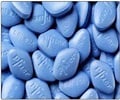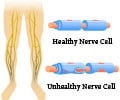Men who suffer from peripheral neuropathy are at an increased risk of developing erectile dysfunction, reveals a Spanish study.

"However our study of 90 patients shows that men with more severe symptoms of peripheral neuropathy, which can be caused by disease, trauma or illness, had greater self-reported ED and required more aggressive treatment.
"Our findings underline the importance of clinicians carrying out neurophysiological tests on patients with ED, particularly in the pelvic area."
The research team, which included experts on both neurophysiology and urology, studied 90 consecutive patients with sexual problems recruited from the hospital's Department of Andrology.
ED was diagnosed using the five-item version of the International Index of Erectile Dysfunction (IIEF-5) and the occurrence of peripheral neuropathy was predicted using the Neuropathy Symptom Score.
A range of neurophysiology tests were carried out to assess the presence of large and small fibre peripheral neuropathy.
The researchers found that:
- The average age of the men in the study was 54 years of age. Ten per cent were under 40 and only two per cent were over 70.
- No significant correlation between IIEF-5 scores and increasing age was found. In fact, younger patients had lower (worse) IIEF-5 scores, which could be due to higher expectations or a higher number of organic risk factors.
- Just under a third of the patients (30 per cent) had cardiovascular disease, 16 per cent had neurogenic risk factors (relating to the nerves or nervous system) 16 per cent had diabetes and 11 per cent had no risk factors. Just over seven per cent had been diagnosed with mental health issues.
- Patients with more severe symptoms of peripheral neuropathy showed lower (worse) IIEF-5 scores and required more aggressive therapies.
- Neurophysiological exploration confirmed that just under 69 per cent of patients had neurological pathology. Of these, 61 per cent had some type of peripheral neuropathy and eight per cent had myelopathy - problems with their spinal chord.
- Just under 38 per cent of the patients had polyneuropathy, which occurs when a number of the peripheral nerves throughout the body malfunction simultaneously. Of these nine per cent had small fibre neuropathy, damage to the small unmyelinated peripheral nerve fibres, and just over 14 per cent had pudendal neuropathy, affecting the somatic nerve in the pelvic region.
- The findings of the sympathetic skin response tests underlined the importance of checking nerve problems in the pelvic area, as response alterations were much more common in the penis than hand or foot.
- No association between neurophysiological diagnosis and IIEF-5 scores was detected, but a statistical association was found between neuropathy and the Neuropathy Symptom Scores.
"By combining feedback from patients with a series of neurophysiological tests we have been able to demonstrate that peripheral neuropathy is highly prevalent in patients with ED.
"However, we found that the IIEF-5 scores and Neuropathy Symptom Scores were not reliable tools for detecting neurological alterations in patients with ED.
"Our findings suggest that clinicians should carry out neurophysiological tests on patients with ED, paying particular attention to the pelvic area."
Source-Eurekalert















